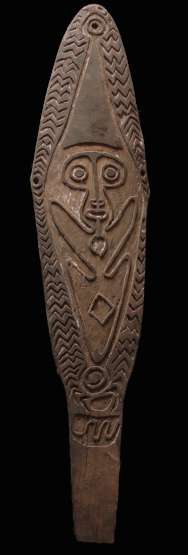Gope boards
Gope Boards (or Kwoi) are wooden ritual objects made in the Papuan Gulf of New Guinea. They represent the spirits of ancestral heroes that can protect clans from evil spirits and death.

Design
Gope is a term for a spiritually charged carved board made to represent an ancestral hero in the Papuan Gulf of Papua New Guinea.[1] Papuan Gulf people of Kikori, Baimaru, Uruma, Hohao, and Orokolo[2] refer to these sculptured boards as Kwoi.
The sculptures are often made from the sides of an old canoe.[3]
Use
Gope sculptures are believed to protect the island clansmen from evil spirits and death[4] A full size board is made and named by the uncle of a boy for his initiation (into adulthood) ceremony. Also, warriors are awarded gope boards for each act of bravery they perform in battle—these boards are often made from the remains of an enemy's canoe. Gope boards have a consistent elliptical shape and can vary in size up to eight feet long. They are carved in relief and then painted with lime (to whiten), red ochre, and other native paints. Gope boards have a similar style and may depict the face of an ancestral spirit. Small unnamed gope boards are sometimes given to uninitiated boys.
In headhunting
Gope boards are also used in raids on other clans and headhunting missions. They are consulted as to which enemy to attack, and the spirits contained in the boards are thought to go in advance of the warriors to sap the enemies of their strength. Agiba (or "skull racks") are similar to Gope boards and are used to display any skulls won in battle[5].
References
- Haddon, A.C. (January 1934). "The Dance of the Gope in Kerewa". Man. 34: 8–9. doi:10.2307/2790892. ISSN 0025-1496. JSTOR 2790892.
- 1950-, Welsch, Robert Louis (2006). Coaxing the Spirits to Dance: Art and Society in the Papuan Gulf of New Guinea. Webb, Virginia-Lee., Haraha, Sebastian., Hood Museum of Art., Metropolitan Museum of Art (New York, N.Y.). Hanover, N.H.: Hood Museum of Art, Dartmouth College. ISBN 094472230X. OCLC 62878649.CS1 maint: numeric names: authors list (link)
- "Children and Youth in History | Gope, Ancestor or Spirit Boards [Object]". chnm.gmu.edu. Retrieved 2018-12-19.
- "Gope Board". Saint Louis Art Museum. Retrieved 2018-12-19.
- "New Guinea Sculpture | Papuan New Guinea Sculpture | Sell Sculpture". new guinea tribal arts. 2018-04-10. Retrieved 2019-01-10.
External links
- Papuan Gulf Map - Information about Papuan Gulf culture.
- Gope Boards - View various Gope Boards (Internet Archive).